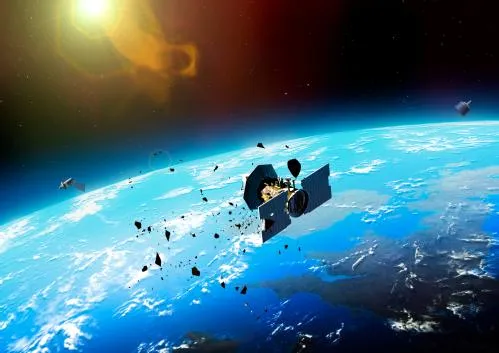Press Releases
Clearing the skies for Santa this Christmas: The researchers tackling junk in space
As scores of children prepare to look to the skies this Christmas Eve, they will be relieved to know scientists are helping to clear a path for Santa in space.
Space is becoming crowded as more and more satellites are launched into the Earth’s orbit. We have a space traffic problem – with junk from satellites, rocket bodies and other debris accumulating in the skies. Determined to tackle this problem, scientists at the University of Warwick are researching these growing threats to the spacecraft we rely on.
The Warwick Centre for Space Domain Awareness (CSDA) is a pioneering network of academics dedicated to understanding the near-Earth environment, drawing from the expertise of multiple groups across the University. The CSDA’s astronomers use telescopes to look for space junk, characterise it, and monitor where it’s going, to better understand the risks posed to the active satellites we care about.
The CSDA conducts surveys of the geosynchronous region, located roughly 36,000 kilometres above the Equator, where satellites orbit with a period that matches the Earth’s rotation in a limited number of orbital slots. They also observe objects much closer to home, in low Earth orbit, where space is most densely packed with artificial debris.
Dr James Blake, Research Fellow at the University of Warwick, is one of the scientists involved in the CSDA. He said: “Artificial debris orbiting the Earth can originate for many reasons: satellites become debris when they reach the end of their mission lifetime; abandoned rocket bodies can explode after years in orbit; collisions can occur between orbiting bodies, resulting in clouds of fragments; the harsh environment of space can deteriorate satellites over time, shedding bits of insulating blanket and paint flakes.
“Space junk is moving extremely fast, covering kilometres every second, so even centimetre-sized objects can destroy an operational satellite, causing disruption both in space and on ground. The concerning thing is that surveillance systems on Earth struggle to detect these dangerous objects, as they’re often very faint, and we know very little about the small debris population.
“We use data from our telescopes in La Palma, Canary Islands, looking at the positions and brightness of objects over time. From their ‘light curves’, we can gain more of an understanding about the objects we’re seeing.
“There are some exciting ideas for recycling satellites and removing debris being tested in space. Often these missions involve getting really close to, or even docking with, the target object, which carries a lot of risk in itself – we don’t want to accidentally create more debris! It’s important to closely monitor these kinds of missions in case something unexpected happens.
“In recent years, we’ve used some of our telescopes to observe Northrup Grumman’s Mission Extension Vehicles approaching and docking with satellites in the geosynchronous region. When the satellites get so close, it becomes really difficult to resolve the two, as they’re so far away. There are plenty of observational hurdles to overcome.”
Earlier this month, the University of Warwick hosted the second annual conference of the Global Network On Sustainability In Space (GNOSIS), with speakers from 16 countries, spanning six continents, reflecting the truly global nature of the problem. During the conference, sixty Year 5s from two local primary schools, Cannon Park and St Elizabeth’s, visited Warwick campus as part of an outreach initiative organised by the University of Warwick, GNOSIS, and PrimarySpace, and sponsored by the Defence Science and Technology Laboratory.
Further details about the conference can be found here.
The CSDA recently published a review of space sustainability research, which can be found here.
Further details of the CSDA’s research activities can be found here.
Image credits:
· Artwork credit – Dr Mark Garlick

University of Warwick press office contact:
Annie Slinn
Communications Officer | Press & Media Relations | University of WarwickLink opens in a new window
Email: annie.slinn@warwick.ac.uk
20 December 2022
